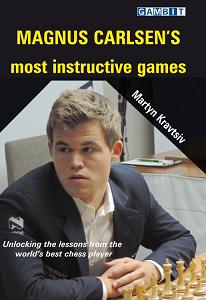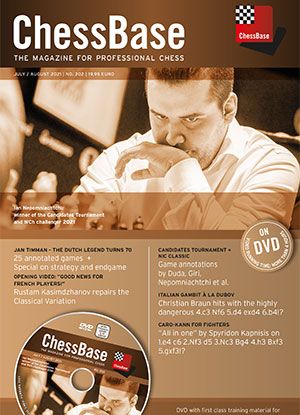CHESSBOOK REVIEWS

Latest book
reviews of 1 August 2021
Wilhelminalaan 33
7261 BP RUURLO
The Netherlands.
John
Elburg
Chess Books

Magnus Carlsen's most instructive games by
Martyn Kravtsiv
2021
Gambit Publications Ltd
http://www.gambitbooks.com
E-mail info@gambitbooks.com
174 pages
Price €22,75
ISBN (13 digits):
978-1-911465-66-9
The Ukraine chess coach Grandmaster Martyn Kravtsiv digs in 42
extensively well analysed games of the great Magnus Carlsen who belongs
to one of the greatest players of all time.
Every games in this book holds a important key point and is related
with an important chess topic.
Magnus Carlsen is a man who loves to play for advantage and initiative,
and this we see back in the analyses and lessons from Martyn
Kravtsiv,where all material of this book is divided in four large
sections: Opening, Middle game, Endgame and Human factors.
Pleasant to mention is that Martyn Kravtsiv avoided Carlsen most famous
games and did prefer to scope on the feature beautiful and unexpected
moves.
Each game has a brief introduction where the author does describe the
main theme,and after the end of the game there is a conclusion that
picks out the
most instructive moments.
One of my favourite games in the book is: Karjakin,Sergey (2753) -
Carlsen,Magnus (2845) [B33]
Gashimov Memorial 6th Shamkir (8), 08.04.2019
1.e4 c5 2.Nf3 Nc6 3.d4 cxd4 4.Nxd4 Nf6 5.Nc3 e5 6.Ndb5 d6 7.Nd5 Nxd5
8.exd5 Ne7 9.c4 Ng6 10.Qa4 Bd7 11.Qb4 Bf5 12.Qa4 Bd7 13.Qb4 Bf5 14.h4
h5 15.Bg5 Qb8 16.Be2 a6 17.Nc3 Qc7 18.g3 Be7 19.Be3 e4 20.0-0 0-0
21.Bxh5 Ne5 22.Be2 Qd7 23.Qa4 Qc8 24.c5 dxc5 25.Nxe4 c4 26.Nc3 b5
27.Qd1 b4 28.Na4 Be4 29.Qd4 Qf5 30.f4 Qg6 31.Bf2 Nd3 32.h5 Qf5 33.Bg4
Qxg4 34.Qxe4 Bd6 35.Qg2 Rae8 36.Bd4 Qxh5 37.Qf3 Qg6 38.Kh1 Re4 39.Bf2
Rfe8 0-1, Karjakin had seen enough and resigned meaning Magnus won the
Shamkir tournament with a round to spare, but also scored his 4th (!)
win in a row vs. 7.Nd5.
Kravtsiv explains,In my opinion Carlsen won this game primarily because
he was much better prepared in the opening.This helped him not only to
get the better position, but one in which he was more familiar with
some key strategic themes, and could play more quickly, establishing a
big lead on the clock.
This all and more is good for nearly four pages of highly instructive
text!
Conclusion: Very educative! On of those super made Gambit
books!

ChessBase Magazine issue 202
July/ August 2021
ChessBase
http://www.chessbase.com
E-Mail
info@chessbase.com
ISSN 1432-8992
Euro 19.95
System requirements:
Minimum: Pentium III 1 GHz, 1 GB RAM, Windows Vista, XP
(Service Pack 3), DirectX9 graphic card with 256 MB RAM, DVD-ROM drive,
Windows Media Player 9, ChessBase 12/Fritz 13 or included Reader and
internet connection for program activation. Recommended: PC Intel Core
i7, 2.8 GHz, 4 GB RAM, Windows 8.1 or Windows 10, DirectX10 graphic
card (or compatible) with 512 MB RAM or better
A great part of this DVD is divided to Grandmaster Jan Timman,who will
turn on 14 December 70.
Not only there are 25 annotated games from the Dutch legend, but there
are more special contribution as from the great endgame expert Karsten
Müller.
The contributions from Müller are a highlight of this ChessBase
Magazine.
A fine example of Timman’s play is:
Timman,Jan H - Radulov,Ivan [D24]
Olympiad-20 Preliminaries G Skopje (3), 21.09.1972
[Krasenkow, Michal]
A young Dutch master against an experienced Bulgarian player, who
received his GM title at the FIDE Congress during the Skopje Olympiad.
1.Nf3 Nf6 2.c4 e6 3.Nc3 d5 4.d4 dxc4 Interestingly, Jan Timman gives a
"dubious"("?!") mark to this move in his Chess Informant annotations.
Nowadays it is one of the most popular continuations for Black in this
position! 5.e4 c5 An old move. [5...Bb4 was played almost
authomatically till recently;
but 5...b5!? has now become popular.] 6.Bxc4 cxd4 7.Nxd4 White has
obtained a clear development advantage. Black must be extremely
careful. 7...a6?! Unnecessary, in my opinion. It was more appropriate
to develop pieces: [7...Bc5 8.Be3 0-0 (but not 8...Nbd7 9.Bxe6! , as in
the famous game Capablanca-Bogoljubow, Moscow 1925) ] 8.e5 Logical.
Development advantage should be used by means of energetic play.
8...Qc7?! [To 8...Nfd7 White can sacrifice a piece: 9.Bxe6! fxe6
(9...Nxe5 10.Bxc8 Qxc8 11.Qe2± 1-0 (26) Markelova,L
(2076)-Chadaeva,T (1835) Moscow 2011) 10.Nxe6 Qa5 (10...Qb6? 11.Nd5)
11.0-0 Nxe5 12.Qb3 with a powerful attack.;
8...Nd5 leads to a clear positional advantage for White: 9.Bxd5 exd5
10.0-0±;
8...Bc5!? is probably the lesser evil. If 9.Nb3 (9.Be3!? Bxd4 10.Bxd4
Nc6 11.exf6 Qxd4 12.Qxd4 Nxd4 13.fxg7 Rg8 14.0-0-0 keeping initiative)
9...Qxd1+ 10.Kxd1 Nfd7 11.Nxc5 Nxc5 - Black is worse but can fight on.]
9.Qe2 Nfd7 10.Bf4?! A natural move keeping a big advantage but [here,
too, 10.Bxe6! fxe6 11.Nxe6 was very strong.] 10...Bc5 [10...Nc6 11.Nxc6
Qxc6 12.0-0±] 11.Rd1 0-0 12.0-0 Completing development. [Jan
Timman recommends 12.Bb3 Bxd4 13.Rxd4 Nc6 14.Rd6 but that is not so
clear due to 14...Qa5] 12...Bxd4 13.Rxd4 Nc6 14.Re4?! Another natural
move - but again not the best! [At first glance, 14.Rd6 doesn't work
due to 14...Ncxe5 but, in fact, White can sacrifice that pawn. After
15.Rd4 Qc5 16.Rfd1 b5 17.Bb3 he obtains full domination, and Black can
hardly avoid material losses.] 14...b5 15.Bd3 Nc5?! [¹15...Bb7
16.Bb1 Rac8 , and Black has the worst behind him.] 16.Re3 Here, too, a
deeper insight would help White find a strong exchange sacrifice:
[16.Bb1! Nxe4 (16...b4 17.Rc4!) 17.Qxe4 g6 18.Qe3 , and Black is in
trouble.] 16...f5? It is hard to say whether Radulov missed White's
tactical response or (rather) wrongly assessed the resulting position.
[16...Nxd3 17.Rxd3 f5 was relatively better although Black's position
is quite gloomy after 18.Rfd1± (Timman)] 17.exf6! Of course!
17...Qxf4 18.Bxh7+! Kxh7 19.Qh5+ Kg8 20.fxg7 Kxg7 21.Rg3+ [But not
21.Qxc5 Bb7! After 22.Rg3+ Kh7 White needn't give a perpetual, he keeps
a strong attack by means of 23.Ne4! Rf5 24.Qc3 but the game move is
much simpler.] 21...Qxg3 22.fxg3 Rxf1+ 23.Kxf1+- White has no material
advantage but his position is completely winning: all (!) Black's
pieces are out of play and can't help his king; moreover, they get
under attack. 23...e5 24.Qg5+ Kf7 25.Nd5 Be6 26.Qf6+ Kg8 27.Qg6+ Kf8
28.Nc7 Bc4+ 29.Kf2 Rd8 30.Qxc6 The first and decisive material gain.
30...Rd2+ 31.Kf3 Rd3+ 32.Kg4 Nd7 33.b3 Bf7 34.Qxa6 Rd4+ 35.Kf5 Ke7
36.Nxb5 In this game we have seen Timman's classical playing style but
also his drawbacks: slightly superficial play and lack of deep insight
into the position. On the other hand, Jan was only 21; besides, it is
easy to give recommendations with the help of modern computers :-). 1-0
But there is more as the following {opening} surveys:
Bogo-Indian: no respite for Black!
Lars Schandorff shows the poisonous 1.d4 Nf6 2.c4 e6 3.Nf3 Bb4+ 4.Bd2
Qe7 5.e3!?
Three times Anish Giri!
Among other things, the Dutchman annotates his impressive victory over
Liren Ding
"Good news for French players!"
Rustam Kasimdzhanov repairs the Classical Variation (opening video)
Italian gambit à la Dubov
Christian Braun hits with the sharp 4.c3 Nf6 5.d4 cxd4 6.b4!?
Novelty by "lapsus manus"!
Mihail Marin shows his discovery in the Grünfeld with 5.Qb3 dxc4
6.Qxc4 0-0 7.e4 Bg4 8.Be3 Nfd7 9.Qb3 Nc6!?
Frighten your opponent – with the Halloween Gambit!
Robert Ris uncorks 1.e4 e5 2.Nf3 Nc6 3.Nc3 Nf6 4.Nxe5 Nxe5 5.d4
Reversed Sicilian: d2-d4 in one go!
Alexey Kuzmin presents White’s plan after 1.c4 e5 2.g3 Nf6 3.Bg2 d5
4.cxd5 Nxd5 5.Nf3 Nc6 6.0–0 Nb6 7.b3
Technique vs. ticking clock
Jan Krzysztof Duda shows why his edge against Hikaru Nakamura at the
NIC Classic was only enough for draw
Caro-Kann for fighters - recapturing like Mikhail Tal
All in one by Spyridon Kapnisis on 1.e4 c6 2.Nf3 d5 3.Nc3 Bg4 4.h3 Bxf3
5.gxf3!?
Pushes, sacs & special moves
Tactics with Oliver Reeh
An all-important full point
The candidates winner Ian Nepomniachtchi elaborates on his hard-fought
endgame victory over Wang Hao.
The game file holds 456 games and where a small 48 of them are more
than excellent analysed.
As the following game: Nakamura,Hikaru (2736) - Carlsen,Magnus (2847)
[D31]
NIC Classic KO chess24.com INT (3.23), 02.05.2021
[Nielsen, Peter Heine]
1.d4 d5 2.c4 e6 3.Nc3 a6!? Having won day 1, Magnus only needed a 2-2
result in order to clinch the title. However day 2 started badly,
losing a rather one-sided game with the black pieces, except from
having missed a beautiful tactic, when suddenly given the chance.
Needing too win one of the remaining 2 games, to avoid a playoff,
Magnus decides to make it less about a theoretical battle, but plays
his pet line which tends to lead to very playable positions, even if
slightly worse. The move might look odd, but the threat of ...dxc4, now
having prepared ...b5, means that White has to release the tension in
the centre. 4.cxd5 exd5 5.Bf4 Nf6 6.e3 Bd6 7.Bxd6 [Nakamura has
previously opted for the more ambitious 7.Bg3 ] but due to the match
standings obviously is happy simplifying.
7...Qxd6 8.Bd3 Bg4 9.Qb3 Nc6 10.h3 Bh5 11.Nge2 [11.Qxb7 is possible,
but after 11...0-0 12.Qb3 Rab8 Black does get a certain intiative for
the pawn.] So Nakamura once again keeps it simple. 11...Bxe2!? An
interesting decision. Generally speaking the bishop, by modern
standards, is rated a little higher than the knight numerically, but as
a set of bishops have been exchanged, at least white does not get " the
pair of bishops". As well it unbalances the position just a bit, and
while White nominally is a bit better here, it leaves scope for Magnus
to outplay his opponent. 12.Nxe2 0-0 13.Rc1 [13.g4!? was the ambitious
way, but Nakamura already has shown such in no way is his intention.]
13...Nd8 14.Qa3 Qd7! Exchanging queens on a3 of course leaves White
with an isolated doubled pawn, yet in this structure, it seems to
matter less. White can with the queens exchanges easily follow up with
f3, g4 etc. keeping both a safe and slightly advantageous position.
15.0-0 g6 16.Nf4 Re8 17.Bc2 c6 18.Nd3 Ne6 Nakamura is making standard
moves and has difficulties improving his position further. He could,
and should start threading waters, but that would allow Magnus to
improve his position with the likes of ...Re7, ...Rae8,...h5, ...Kg7
etc. So there is logic in reacting now, it however backfires horribly:
19.f4 Ng7 20.f5 g5! Suddenly White has irrepariably weakened his
position. Black's knights block the queenside well, and the pawn at g5
cannot easily be attacked. Nakamura has pinned his hopes on accessing
the e5 square, but.... 21.Ne5 Qc7 22.h4 g4 23.Qc3 Ngh5 24.Qe1 Rxe5!
Petrosian would call it trivial, and rightly so. In principle it is a
material sacrifice, but for the exchange Black gets a pawn, and full
control of the position. The e-file and the e5 square at first, but as
will be seen later, allowing access to the g3 square, it was really
brings White down. 25.dxe5 Qxe5 26.Qc3 Qg3! 27.Qe1 Qd6 Not that endings
wouldn't be advantageous for Black, but with the white king potentially
weak, keeping them on seems even more efficient. 28.Qf2 Re8 29.Rcd1 Qe5
30.Rd4 c5 31.Rd2 Ng3 32.Rfd1 Kf8 Not strictly necessary, but a sign of
strength. Black can queitly safeguard his position even further, as
White has absolutely no positive options. 33.Rd3 Nfe4 34.Qe1 Qf6!
Attacking the h4-pawn, with which dissapearance the white position
collapses as Black gets direct access to his king: 35.Rxd5 Qxh4 36.Bxe4
Qh1+ 37.Kf2 Nxe4+ 38.Ke2 Qxg2+ 39.Kd3 But with many move winning,
39...Nf2+ perhaps being the simplest, Nakamura resigned. 0-1.
Conclusion: This is must have material!

